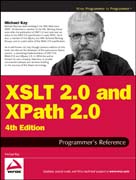
This book is primarily a practical reference book for professional XSLT developers. It assumes no previous knowledge of the language, and many developers have used it as their first introduction to XSLT; however, it is not structuredas a tutorial, and there are other books on XSLT that provide a gentler approach for beginners. The book does assume a basic knowledge of XML, HTML, and the architecture of the Web, and it is written for experienced programmers. There’s no assumption that you know any particular language such as Java or VisualBasic, just that you recognize the concepts that all programming languages have in common. The book is suitable both for XSLT 1.0 users upgrading to XSLT 2.0, and for newcomers to XSLT. The book is also equally suitable whether you work in theJava or .NET world. As befits a reference book, a key aim is that the coverage should be comprehensive and authoritative. It is designed to give you all the details, not just an overview of the 20 percent of the language that most people use 80 percent of the time. It’s designed so that you will keep coming back to the book whenever you encounter new and challenging programming tasks, not as a book that you skim quickly and then leave on the shelf. If you like detail, you will enjoy this book; if not, you probably won’t. But as well as giving the detail, this book aims to explain the concepts, in some depth. It’s therefore a book for people who not only want to use the language but who also want to understand it at a deep level. The book aims to tell you everything you need to know about the XSLT 2.0 language. It gives equal weight to the things that are new in XSLT 2.0 and the things that were already present in version 1.0. The book is about the language, not about specific products. However, there are appendices about Saxon (the author’s own implementation of XSLT 2.0), about the Altova XSLT 2.0 implementation, and about the Java and Microsoft APIs for controlling XSLT transformations, which will no doubt be upgraded to handle XSLT 2.0 as well as 1.0. A third XSLT 2.0 processor, Gestalt, was released shortly before the book went to press, too late to describe it in any detail. But the experience of XSLT 1.0 is that there has been a very high level of interoperability between different XSLT processors, and if you can use one of them, then you can use them all. In the previous edition we split XSLT 2.0 and XPath 2.0 into separate volumes. The idea was that some readers might be interested in XPath alone. However, many bought the XSLT 2.0 book without its XPath companion and were left confused as a result; so this time, the material is back together. The XPath reference information is in self-contained chapters, so it should still be accessible when you use XPath in contexts other than XSLT. The book does not cover XSL Formatting Objects, a big subject in its own right. Nor does it cover XML Schemas in any detail. If you want to use these important technologies in conjunction with XSLT, there are other books that do them justice. Michael Kay has been working in the XML field since 1997; he became a member of the XSL Working Group soon after the publication of XSLT 1.0, and took over as editor of the XSLT 2.0 specification in early 2001. He is also a member of the XQuery and XML Schema Working Groups, and is a joint editor of the XPath 2.0 specification. He is well known not only through previous editions of this book but also as the developer of the open source Saxon product, a pioneering implementation of XSLT 2.0, XPath 2.0, and XQuery 1.0. In 2004 the author formed his own company, Saxonica, to provide commercial software and services building on the success of the Saxon technology. Previously, he spent threeyears with Software AG, working with the developers of the Tamino XML server,an early XQuery implementation. His background is in database technology: after leaving the University of Cambridge with a Ph. D., he worked for many yearswith the (then) computer manufacturer ICL, developing network, relational, and objectoriented database software products as well as a text search engine, and held the position of ICL Fellow. INDICE: Introduction. List of Examples. Part I: Foundations. Chapter 1: XSLT in Context. Chapter 2: The XSLT Processing Model. Chapter 3: Stylesheet Structure. Chapter 4: Stylesheets and Schemas. Chapter 5: Types. Part II: XSLT and XPath Reference. Chapter 6: XSLT Elements. Chapter 7: XPath Fundamentals. Chapter 8: XPath: Operators on Items. Chapter 9: XPath: Path Expressions. Chapter 10: XPath: Sequence Expressions. Chapter 11: XPath: Type Expressions. Chapter 12: XSLT Patterns. Chapter 13: The Function Library. Chapter 14: Regular Expressions. Chapter 15: Serialization. Part III: Exploitation. Chapter 16: Extensibility. Chapter 17: Stylesheet Design Patterns. Chapter 18: Case Study: XMLSpec. Chapter 19: Case Study: A Family Tree. Chapter 20: Case Study: Knight’s Tour. Part IV: Appendices. Appendix A: XPath 2.0 Syntax Summary. Appendix B: Error Codes. Appendix C: Backward Compatibility. Appendix D: Microsoft XSLT Processors. Appendix E: JAXP: The Java API for Transformation. Appendix F: Saxon. Appendix G: Altova. Appendix H: Glossary. Index.
- ISBN: 978-0-470-19274-0
- Editorial: John Wiley & Sons
- Encuadernacion: Cartoné
- Páginas: 1400
- Fecha Publicación: 03/06/2008
- Nº Volúmenes: 1
- Idioma: Inglés
